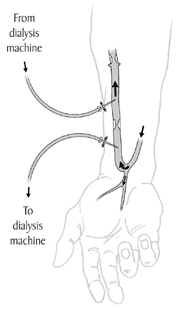Cimino fistula

Template:WikiDoc Cardiology News Editor-In-Chief: C. Michael Gibson, M.S., M.D. [1]
A Cimino fistula, also Cimino-Brescia fistula and arteriovenous fistula, is a type of vascular access for hemodialysis. It is a surgically created connection between an artery and a vein in the forearm.
Theoretical basis
AV fistulas work effectively because they:
- Have high volume flow rates (as blood takes the path of least resistance; it prefers the (low resistance) AV fistula over traversing (high resistance) capillary beds).
- Native blood vessels, when compared to synthetic grafts,[1] are less likely to develop stenoses and fail.
History
The procedure was invented by doctors Cimino and Brescia in 1966.[2] Before the Cimino fistula was invented, access was through a Scribner shunt, which consisted of a Teflon tube with a needle at each end. Between treatments, the needles were left in place and the tube allowed blood flow to reduce clotting. But Scribner shunts lasted only a few days to weeks. Frustrated by this limitation, Dr. James Cimino recalled his days as a phlebotomist (blood drawer) at New York City's Bellevue Hospital in the 1950s when Korean War veterans showed up with fistulas caused by trauma. Cimino recognized that these fistulas did not cause the patients harm and were easy places to get repeated blood samples. He convinced surgeon Kenneth Appel to create some in patients with chronic kidney failure and the result was a complete success. Scribner shunts were quickly replaced with Cimino fistulas, and 40 years later, they are still the most effective, longest-lasting method for long-term access to patients' blood for dialysis.